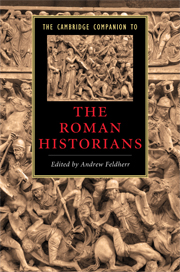Book contents
- Frontmatter
- Introduction
- Part I Approaches
- Part II Contexts and Traditions
- Part III Subjects
- Part IV Modes
- Part V Characters
- Part IV Transformations
- 20 Josephus
- 21 The Roman exempla tradition in imperial Greek historiography: The case of Camillus
- 22 Ammianus Marcellinus: Tacitus’ heir and Gibbon’s guide
- 23 Ancient Roman historians and early modern political theory
- 24 Re-writing history for the early modern stage: Racine’s Roman tragedies
- 25 The Roman historians and twentieth-century approaches to Roman history
- Chronological list of the historians of Rome
- Bibliography
- Index
22 - Ammianus Marcellinus: Tacitus’ heir and Gibbon’s guide
from Part IV - Transformations
Published online by Cambridge University Press: 28 November 2010
- Frontmatter
- Introduction
- Part I Approaches
- Part II Contexts and Traditions
- Part III Subjects
- Part IV Modes
- Part V Characters
- Part IV Transformations
- 20 Josephus
- 21 The Roman exempla tradition in imperial Greek historiography: The case of Camillus
- 22 Ammianus Marcellinus: Tacitus’ heir and Gibbon’s guide
- 23 Ancient Roman historians and early modern political theory
- 24 Re-writing history for the early modern stage: Racine’s Roman tragedies
- 25 The Roman historians and twentieth-century approaches to Roman history
- Chronological list of the historians of Rome
- Bibliography
- Index
Summary
The extant books of Ammianus Marcellinus' Res Gestae cover the deeds of emperors and high officials in the quarter-century between 353 and 378 CE. The work is adorned with all the apparatus of classical historiography: prefaces, digressions, set speeches, battles and sieges, treason trials, and natural disasters. Yet for the historian of Latin historiography, or the compiler of a companion to it, Ammianus is an awkward fit. Many general works on the Roman historians stop over two and a half centuries earlier with Tacitus: a fine climax, and an inept ending. One of the more notable twentieth-century contributions to Ammianus scholarship, Edward Thompson's The Historical Work of Ammianus Marcellinus (1947), opens with the thought that “for every reader of his work nowadays there are a thousand readers of Sallust, Livy or Tacitus.” This was probably never true, and the vast expansion of interest in the late Roman world ensures that scholarship on Ammianus is now quite as hard to keep up with as on the other three great Roman historians. But what was and remains true is that Ammianus is terra incognita for most classicists, including many historiographical specialists.
- Type
- Chapter
- Information
- The Cambridge Companion to the Roman Historians , pp. 348 - 361Publisher: Cambridge University PressPrint publication year: 2009
- 5
- Cited by

